Geology / Gallery

Ischadites koenigi (7)
Sponges ➚ are a primitive form of multi-cellular animal. They present the remarkable ability of re-assembling themselves into their original form after being broken into small fragments. It is this ability that suggests a link to the process of differentiation of cells in higher organisms. Sponges have been touted as a possible long term ancestor of all vertebrates.
A wide variety of forms have been present from the earliest Cambrian ➚ to the present day. Only calcareous sponges are preserved well in the fossil record and as classification is chiefly by soft parts they are of limited stratigraphical value. At times sponges have produced fossil reefs just as large and widespread as coral reefs, particularly during the Jurassic. Individual cells in the colony co-operate to filter incoming water containing microscopic food particles.
Iscadites koenigi lived in the Ordovician dying out during the early Silurian.
| Division | Name |
| Phylum | Porifera |
| Class | Calcarea |
Fossil gallery
- Brittle Star : Lapworthia miltoni
- Trilobite : Dalmanites myops
- Crinoid : Eucalyptocrinites decorus
- Gastropod : Poleumita discorus
- Trilobite : Calymene blumenbachi
- Graptolite : Cyrtograptus murchisoni
- Sponge : Ischadites koenigi
- Conodont : Ozarkodina typica
- Brachiopod : Pentamerus oblongus
- Graptolite : Petalograptus minor
- Brachiopod : Chonetes striatellus
- Cystoid : Lepocrinetes quadrifasciatus
- Bivalve : Pteronitella retroflexa
- Graptolite : Monograptus lobiferus
- Gastropod : Platyceras haliotis
- Crinoid : Sagenocrinites expansus
- Brachiopod : Atrypa reticularis
